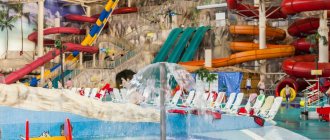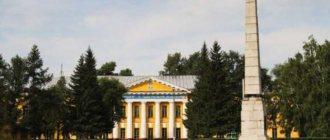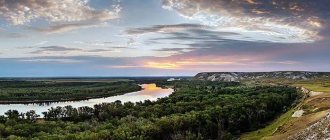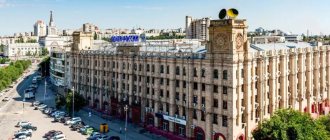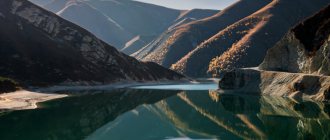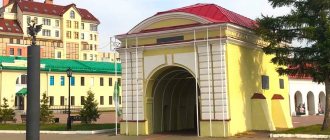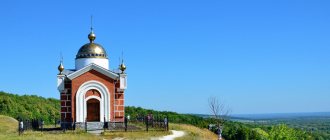Volgograd is a hero city, formerly known as Stalingrad, which begins its history in July 1589. Initially, the city was called Tsaritsyn, since it was located on an island in the Tsarina River; it was built as a defensive fortress.
The indigenous people named the river Sary-Su, which means “yellow/muddy water,” and the city itself was named Sary-Sin, which is translated from Turkic as “yellow island.” There is a legend among the locals that this name was received from Empress Catherine the Great. Thanks to her merits, German colonists appeared in Tsaritsyn. They grew mustard, from which they prepared the famous and adored Sarepta oil.
It is known that before Catherine II, the reformer Peter I was interested in the city. In 1925, Tsaritsyn was renamed Stalingrad, where the fateful Battle of Stalingrad took place, which turned the tide of the war. In November 1961, it received its modern name Volgograd.
The city has several awards: “Golden Star”, Order of the Red Banner. Volgograd has something to be proud of, because it was here that such important events took place:
- The emergence of the first professional doctors
- Opening of the theater for young spectators
- Creation of a private gallery "Vernissage"
- Holding the first International Festival "Kayfedra", dedicated to the new style in avant-garde art
- The first radio station began broadcasting in FM format
Tourists visit Volgograd to improve their health in the salt lake Elton and take mud baths, ride horses, go on a river cruise, go on pilgrimages, visit cultural and entertainment centers and attractions.
For those traveling by car: the most interesting natural and historical places of the Volgograd region.
Historical sites and museums
Historical and Memorial Museum-Reserve "Battle of Stalingrad"
Address of the Museum “Battle of Stalingrad”: Telephone: Website: www.stalingrad-battle.ru Opening hours: Tue – Fri: from 10.00 to 18.00, Sat: from 10.00 to 20.00, closed on Monday. From November 1 to March 31, every Thursday - from 13.00 to 21.00, from April 1 to October 31, every Thursday - from 10.00 to 21.00. Entrance ticket cost: for adults – 250 rubles, for students – 150 rubles. The cost of the excursion for a group of 10 to 30 people: for each adult – 150 rubles, for each student and schoolchild – 100 rubles. Schoolchildren under 16 years of age can visit the Battle of Stalingrad Museum without a guided tour for free!
Address of the Memory Museum: pl. Fallen Fighters, 2 TSUM, basement Telephone: Website: www.stalingrad-battle.ru Opening hours: Tue – Sat from 10.00 to 18.00, closed on Monday. Entrance ticket cost: for adults – 100 rubles, for students – 50 rubles. The cost of the excursion for a group of 7 to 30 people: for each adult – 100 rubles, for each student and schoolchild – 70 rubles. Schoolchildren under 16 years of age can visit the Memory Museum without a guided tour for free!
Since 2008, it has included the “Battle of Stalingrad” panorama museum and the historical and memorial complex “Heroes of the Battle of Stalingrad” on Mamayev Kurgan.
In the panorama museum, exhibitions are housed in 8 halls, and dioramas in four more. There is a cinema hall and a military-historical library in separate rooms. Of great interest are the monuments to the sailors of the Volga Flotilla: the ruins of a steam mill and the armored boat “Gasitel”, which lasted almost the entire course of the battle.
In 2012, the “Memory” museum in the basement of the city Central Department Store became the object of the museum complex. It commemorates the capture of Wehrmacht General Friedrich Paulus by Soviet troops. The exhibition displays photographs of the historical reconstruction of captivity, German motorcycles and vehicles, large-sized bladed weapons and firearms of both armies.
Mamayev Kurgan with the famous Motherland monument rises in the very center of Volgograd. It was for the mastery of this hill that mortal battles were fought until the victory in the Battle of Stalingrad. The reason is simple - the whole city was shot at from it.
The ensemble of the memorial mound includes:
- Ruin walls;
- Hall of Military Glory;
- Memorial Cemetery;
- Square of Heroes, Sorrow and Those Who Stand to Death.
Volgograd Museum of Fine Arts
Address of the central building of the museum: Lenin Ave., 21 exhibition hall: st. Chuikova, 37 Phone: Website: https://mashkovmuseum.ru/ Opening hours: Thu-Mon 10:00 - 18:00, Tue - closed, Wed 10:00 - 20:00 Entrance fee: for adults - 200 rubles , for students and pensioners - 150 rubles, for schoolchildren - 100 rubles.
There is only one art museum in Volgograd, but what a great one! His exhibitions include works:
- Russian artists of the 18th-20th centuries, among them Aivazovsky and Savrasov, Shishkin and Polenov, Kuindzhi and Nikolai Roerich, Kustodiev and Tropinin;
- Russian sculptors of the 18th-19th centuries - master of small sculpture Ilya Ginzburg, creator of marble busts Fedot Shubin, connoisseur of horses and admirer of their beauty Evgeniy Lanceray, Nikolai Andreev - an ardent admirer of Vladimir Lenin (about 100 sculptures and 200 graphic images), Rodin's student Anna Golubkina;
- Painters of the 20th century (Soviet period) who belonged to the Moscow school - Ilya Mashkov, Pyotr Konchalovsky, Robert Falk; Leningrad school - Petrov-Vodkin, Isaac Brodsky;
- Sculptors of the 20th century (Soviet period) - Alexander Rukavishnikov, Zurab Tsereteli, Sergei Konenkov, Ernst Neizvestny.
The number of paintings of the 20th century is over 1200, sculptural forms – more than 250.
The museum's newest collection is of Russian icons from the 13th to 20th centuries. Collection of graphics by artists of the 18th-20th centuries - more than 2000 canvases. Four halls demonstrate the work of Volgograd painters.
But that is not all!
Foreign art in the Volgograd museum is represented by paintings and graphics of the “little Dutch” and European artists of the 17th-20th centuries: Rosa Salvator, Annibale Caracci, Jacques Callot, Rembrandt and Fernand Léger.
Selected collections:
- Casts of ancient sculpture;
- Porcelain from China, Iran, Japan, India;
- Scrolls and woodcuts from Iran, Turkmenistan, Arab countries of the Middle East.
The total number of exhibition units of the museum is more than 9000.
Museum-reserve "Old Sarepta"
Address: st. Izobilnaya, 10 Phone: Website: www.altsarepta.ru Opening hours: Tue-Sun 9.30-17.30, closed on Monday, break from 12.30-13.00 Viewing the exhibition without a guide: for adults - 200 rubles, for students and pensioners - 160 rubles, for schoolchildren – 120 rubles. Cost of the excursion: for adults – 300 rubles, for students and pensioners – 250 rubles, for schoolchildren – 200 rubles.
A unique museum on the territory of the only settlement of Moravian brothers from Germany in Russia.
The permanent exhibitions of the museum are dedicated to the life, culture, and peculiarities of the religious beliefs of the Sarepta settlers in the Volga region. German colonists took precedence in growing potatoes and tobacco, producing mustard and mustard oil on these lands.
The attraction of the reserve is a white wooden organ located in a functioning church. It performs works of classical music as part of concert programs.
The very first stone buildings of the city have been preserved on the territory of the reserve: a church (1772) and a distillery. Other one- and two-story buildings housed the library and the central building of the museum-reserve; these buildings have been restored, the rest have not yet.
During the excursion you can try traditional Sarepta cuisine, play table tennis and billiards.
The first Computer Museum in Russia is located in the library building. Its exposition is about electronic computing technology from the 1970s to the 1990s. Here is a laptop the size of a suitcase and weighs as much as a concrete slab, a calculator that takes up more than half of the table on strong oak legs - weak supports may not support 25 kilograms of its weight. A “light” tablet weighs only two kilograms, and a hard drive with ten megabytes of memory takes up an entire room.
Museum of Weights and Measures
Address: Aviatorov Highway, 11A Telephone: +7 (ext. 705) Website: https://museum.vzvt.ru/ Opening hours: Mon-Fri 9:00 - 18:00, Sat, Sun - closed, visiting possible pre-registration Cost: adult - 150 rubles, reduced price - 100 rubles.
A solid collection of the museum began to be assembled in the early 1990s, a significant part of it being the funds of the Volgograd museum, which ceased its activities in 1990. Among the exhibits are scales for a wide variety of purposes: household and industrial, for medical institutions and nuclear power plants, weights from huge to microscopic, designed for weighing the lightest elements of the periodic table. Books on the development of units of measurement and documents that approved them. Unique photographs of measuring instruments and original measured objects. Postcards dedicated to the anniversaries of different units of measurement, chambers of weights and measures from around the world.
There are more than 2000 exhibits of high historical value in the Museum; they date from the 16th to the 20th centuries, the oldest from the twelfth!
Memorial Historical Museum
Address: st. Gogolya, 10 Phone: (ext. 1104) Website: www.stalingrad-battle.ru Opening hours Tue – Sun from 10.00 to 18.00, closed on Monday. Entrance ticket cost: for adults – 100 rubles, for schoolchildren – 50 rubles.
Amid comprehensive coverage of Stalingrad's decisive role in the outcome of World War II, life in the city at the beginning of the 20th century remains in the shadows. The Volgograd Memorial and Historical Museum manages to cover it, telling in detail about the participation of the city of Tsaritsyn in the Civil and First World Wars.
In addition to the period of the mentioned wars, the museum’s exhibitions tell about the life of the townspeople of the working and noble classes, the famous emigrants of the first wave who left Tsaritsyn for Paris and Berlin.
Unexpectedly, among the exhibits of the museum, a life-size armored personnel carrier, a machine-gun cart riddled with shells from the times of Denikin, a “small” telegraph apparatus from the 20s of the last century and a home telephone from those years - almost miniature in comparison with it - look unexpected.
Small details include: men's and women's clothing (original), jewelry, household items and furniture.
Pavlov's House (House of Soldier's Glory)
Address: st. Sovetskaya, 39
The building was built in the 30s according to the plan of the architect Voloshinov. The house was named after Sergeant Yakov Fedotovich Pavlov, who led the assault group.
The monument is a practically destroyed building, in which during the Great Patriotic War a small group held the defense in order to defend the city and not allow the enemy to win. The battle lasted 58 days and claimed many lives.
A brick wall has been preserved from the building, where it is written: “We will defend our native Stalingrad!” During the restoration of Volgograd, the letter “r” was added, now the inscription reads: “Let's rebuild our native Stalingrad!”
Tower of the Tsaritsyn fire brigade
Address: st. Kommunisticheskaya, 5
The tower of the Tsaritsyn fire brigade was built in 1897. It served the function of alerting the population: bronze balls were hung on it, which helped to understand where the fire occurred by changing the number from 1 to 4.
In the 30s it was destroyed in connection with the construction of the executive committee. In the post-war period, the building was reconstructed, but there was a strong fire, which caused enormous damage to the structure. For a long time it was in a dilapidated state.
The tower was completely restored at the beginning of the 21st century using special bonded masonry.
Some scenes from the film "Stalingrad" were filmed inside.
Gerhardt's Mill
Address: st. them. Marshala Chuikova, 47
Gerhardt's Mill is a dilapidated building that is part of the Battle of Stalingrad museum complex. The mill was built in 1900 and then rebuilt in 1908 after a fire.
It produced oil, smoked fish, baked bread and ground flour. The company was ahead of its time and had high-quality equipment.
In 1942, it served as a valuable strategic point and was a defensive fortress during the war.
In the courtyard of the mill there is a fountain “Children's Round Dance”.
Volgograd Museum of Local Lore
Address: ave. im. Lenina, 7 Phone: Website: https://vokm134.ru/ Opening hours: 09:00-18:00 Wed-Sun, Mon-Tue - closed Cost: adult ticket - 150 rubles, children's ticket - 100 rubles
The complex was founded in November 1914 as the Tsaritsyn Museum of the local region. During the Civil War, the building was destroyed and abandoned for several years.
The museum staff put it in order, and in 1921 it was opened to the public. The museum's exhibits were practically destroyed during the defense of Stalingrad. The surviving exhibits were moved to the village of Tsvetochnoye, and the collection returned to its homeland in the late 80s.
Now it houses more than 150 thousand objects and several permanent exhibitions on topics: nature, archeology and history. Visitors will be able not only to listen to guides, but also to participate in interactive programs, quests, holidays, readings and conferences.
Memorial "Lyudnikov Island"
Address: st. Taimyrskaya, 14
The Lyudnikov Island Memorial is considered the main local attraction, reminiscent of the bloody battles of the Great Patriotic War.
The building served as a warehouse that supplied soldiers with weapons, and through it enemies could get to the banks of the Volga. The team led by Ivan Lyudnikov managed to withstand a 40-day siege and prevent the enemy from leaving.
The monument was called an “island” because the Nazis surrounded Soviet soldiers at a distance of less than 1 km. Only ruins remain of the original structure.
Near the memorial you can see several mass graves and a 10-meter Orthodox cross.
Monuments, streets
Central embankment of Volgograd
Address: 62nd Army embankment
To make it easier for pedestrians to descend to the water, the embankment was made up of two tiers. The upper one adjoins parks and residential areas, the lower edge touches the water, and between them there are monuments and fountains.
At the peak of the development of steamship navigation on the waters of the Volga along the Volgograd coast (then Tsaritsyn), berths appeared chaotically and warehouses were built. Despite the numerous trade routes through the city, the embankment remained ugly and abandoned.
By the beginning of the 20th century, in order to improve the upper part of the embankment, acacia trees were planted on it, slopes were arranged, and a wooden staircase was installed to descend to the pier, but all this was destroyed by a landslide in 1913. In the 1930s, the Soviet government took over the reconstruction; it destroyed three Orthodox cathedrals, small warehouses and paved the passage along the berth line, planting only the slopes. The embankment acquired a beautiful appearance, which was preserved before the war. Throughout the 6.5 months of the Battle of Stalingrad, food and ammunition were delivered to the embankment, and the wounded were evacuated from it.
The exquisite buildings of the embankment became a large central staircase with symmetrical propylaea of eight columns.
Sights and monuments of the embankment:
- The huge building of the river station is almost 300 meters long, 47 meters high with a “puck”. The capacity of the waiting room is 700 people, the number of ships, six ships can simultaneously moor at the station. A concert hall with an organ made in the Czech Republic is also located here.
- The water pumping building is the only building from the 19th century to the present day that is used for its intended purpose.
- Church of John the Baptist, built on the site of the foundation of the first church in Tsaritsyn made of stone.
- The bronze sculpture of Saints Peter and Fevronia by sculptor Konstantin Chernyavsky, installed near the temple in 2012, became the 12th monument to these saints in Russia.
- The Art Fountain, which depicts Russian folk dance, has been decorating the embankment since 1957.
- Monuments of the 21st century include: the monument to the victims of political repression “Going into the Sky”, the monument to the builders-prisoners of the failed Volga-Don canal and the bridge across the Volga.
Fountain "Art" / "Friendship of Peoples"
Address: intersection of st. Alley of Heroes and Marshal Chuikov
The Art Fountain is one of the symbols and the main fountain of the city of Volgograd, installed in 1957.
Bronze figures of dancing girls are created based on the images of the Beryozka group. The project was led by sculptor Aleshin and architect Shalashov.
Avenue of Heroes
Address: intersection of the Square of Fallen Fighters and the Embankment named after. 62 Armies
The Alley of Heroes is an architectural ensemble and one of the central boulevards of the city, which preserves the memory of the heroes of Stalingrad.
The street appeared in the post-war period under the leadership of Soviet architects Alabyan, Levitan and Goldman, when Volgograd was being restored.
In the Alley of Heroes there are steles with the names of Heroes of the USSR.
Monument to Mikhail Panikakha
Address: st. Tarashantsev, 5
The monument of regional significance was created in May 1975 and is located on the site of the feat of the Soviet soldier.
Mikhail Averyanovich Panikakha is a Hero of the USSR, who, being on fire due to failure with the first bottle of fuel, overcoming the pain, rushed at the fascist tank and set it on fire with the second.
To this day, the memorial preserves the memory of courage and devotion to the Motherland and people.
Where to go to eat
There are also interesting places for lovers of gastronomic tourism. There are several restaurants in the city that will surprise even the most picky eaters.
Gastropub "Library"
A unique place, reminiscent of a traditional English pub in its atmosphere. It is here that guests will be offered to enjoy beer brewed according to an ancient recipe. Live music and a cozy interior dilute the stiffness inherent in the British and help you relax.
In summer, you can choose a table on the open veranda and admire the colorful city. And in winter, warm up by the real fireplace located in the hall. The restaurant often hosts concerts, with local and Russian stars performing.
Guests are offered Russian, European, German cuisine. The menu has vegetarian dishes and children's food, so you can go with your child.
The restaurant is located on the Alley of Heroes, but you can order home delivery.
Cooking “Candy-lambs”
One of the most famous culinary shops in the city of Volgograd, and this is not just one shop, but a whole chain. Customers are offered not only pastries and desserts, but also full meals, including:
- baked fish and meat;
- all kinds of salads;
- dumplings, khinkali, dumplings;
- pancakes with various fillings.
Semi-finished products are always in stock, and it is also possible to place an order. The culinary shop provides delivery, so guests of the city do not need to worry; they will always be provided with a tasty and satisfying dinner.
Cafe "Marusya"
Another place that is popular among Volgograd residents is the Marusya cafe. Its distinctive feature is delicious homemade food with European presentation. Here you can have breakfast with pancakes or cheesecakes, and have a hearty lunch with a large selection of first and second courses.
It is noteworthy that the cafe independently produces cheeses with a unique, delicate taste, so if you are in Volgograd, “Marusya” is a must-visit.
Churches and temples
Church of All Saints
Address: st. Mamaev Kurgan, 4 Phone: Website: https://www.volgaprav.ru/hramy_volgograda/centralnyj-rajon/xram-vsex-svyatyx/#.XB4FcusufIV
The Church of All Saints was erected in 2005 on top of the Mamayev Kurgan memorial. The shrine is a monument to fallen soldiers.
On the territory of the memorial complex there is the Vladimir Chapel. The temple contains the first handmade icons, on which the Saints are depicted in three-dimensional form. The images are made of glass, gold and silver threads and beads. A similar manufacturing technology was used 500 years ago.
The shrine is also decorated with an iconostasis painted by the famous icon painter V. Savelyev.
Kazan Cathedral
Address: st. Lipetskaya, 10 Phone: Website: https://volgograd-sobor.ru/ Opening hours: 07:00-19:00 Mon-Sun
The cathedral was built at the end of the 19th century at the expense of parishioners. Temple in pseudo-Russian style.
War and devastation left only the walls from the previous structure. After the victory over the Nazis, reconstruction began. The villagers found out about this and brought to the temple the icon of the Kazan Mother of God and the crucifix, which are still there. The walls of the shrine are also decorated with works by the artist P. Sherdakov.
They say that in the post-war period, people came to the walls of the cathedral to leave a message about a missing loved one and pray for a speedy reunion. Miracles happened and families regained mothers, fathers, spouses and children.
Now on the territory of the Kazan Cathedral you can spend time with your family on the playground, which is located in the courtyard of the temple.
Tsaritsyn Beit David Synagogue
Address: st. Port Said, 11 Phone: Website: eaicy-dar.ru
Beit David Synagogue began operations in 1888 and was the first synagogue school. The building is made in the Moorish style and is one of the surviving buildings from the Tsaritsyn era.
It got its name from the former leader of the Jewish community, David Kolotin.
At the moment, the synagogue building is a physiotherapy clinic, where a six-pointed star visible through the paint serves as an echo from the past.
Temple of John of Kronstadt
Address: st. Tumayana, 38 Phone: Website: https://ik-hram.prihod.ru Opening hours: 07:00-19:00 Mon-Sun
The Church of John of Kronstadt was built in the early 90s and improved to a larger size in 2012. It is named after Father John, who is known for his generosity, kindness and compassion for others, and is nicknamed the People's Elder.
The building is made in the Russian-Byzantine style. Inside there is an icon of St. John - the main and most valuable shrine.
There are also Sunday schools in the temple and a library.
Save your trip summary too!
- Tickets to Volgograd – ~2000 rubles from the capital.
- Chicken Kiev, eaten on the way – 50 rubles. Take it with cheese and mushrooms!
- Lunch in the kitchen – ~200-250 rubles per person.
- Museum of the Captivity of Marshal Paulus – 50 rubles. adults, 30 rub. – children, students. Cats are not allowed.
- Magnets – ~from 80 rub. per piece
- Time spent walking ~ 4-5 hours (with breaks for food and museum)
But that is not all! Ahead of us is Mamaev Kurgan and the Motherland! You need to see it today in order to go to the “Stalingrad Panorama” tomorrow. I invite you too!
Entertainment
Excursions along the Volga
Addresses where you can purchase a ticket for the ship:
- 62nd Army embankment, 6 (River Station building, 1st floor)
- st. Fadeeva, 43 (Krasnoarmeysky district)
- ticket offices on the embankment near the piers
Telephone: , 38-10-81 time of ships from 11.00 to 24.00 every hour from 04/18/2015 to 11/1/2015 Cost: for adults - 300 rubles, for children - 150 rubles.
Excursions on the boat are short - only an hour. During the voyage you will see panoramas of the central districts of the city, monuments at its heights, the Volga sails, the ship will approach the floating monument to sailors and the “dancing” bridge. During the river walk, the guide talks about the history of the city, its monuments, architecture and traditions.
Volgograd Planetarium
Address: st. Gagarina, 14 Phone: Website: https://volgogradplanetarium.ru/ Opening hours: 09:00-18:00 Mon-Sun Cost: adult ticket - 300 rubles, children's ticket - 200 rubles
Already in the fall of 1954, the planetarium opened its doors to receive visitors. The building served as a gift to the entire city, which became a symbol of the desire for progress and peace.
The Volgograd Planetarium is included in the list of the best planetariums in the country and is considered the largest in the Middle and Lower Volga.
Scientific and educational programs, excursions are held here, the history of creation is told, and an astronomical club operates. For example, tourists can visit the Star Hall, where they will get acquainted with the exhibits, see an experiment with a Foucault pendulum, and will also be transported into outer space thanks to the projection on the dome.
The space journey will be accompanied by a story about astronomical objects and phenomena.
Volgograd embankment
I really liked the embankment of this hero city. Everywhere is clean and orderly. It can be seen that for Victory Day they made cosmetic repairs and put everything in order.
Attractions and activities in the surrounding area
Water park "XXI century"
Address: Volzhsky, Lenin Ave., 326 Phone: Website: https://aquapark-21vek.rf Opening hours: 10:00-22:00 Mon-Sun Cost: price list is on the website How to get there: by minibus No. 246
The water park was opened in 2006 and has summer and winter areas. It is ready to receive guests all year round.
This is an ideal place to relax: a variety of slides and pipes, swimming pools for various purposes, a jacuzzi, a sauna, attractions, trampolines, cafes and bars.
Museum of Russian Fairy Tales
Address: Kirovets, st. Lenina, 16 Phone: Website: museum-russian-skazki.rf Opening hours: 10:00 - 18:00 Sat-Sun Cost: price list is on the website
Construction of the Russian fairy tale museum began in 2005. Now it is a place where every guest can find himself among the heroes of fairy tales; even excursions are conducted in poetic form.
Visitors will visit characters familiar from childhood in Lukomorye, in the Royal Chambers, in the Far Far Away Kingdom and other sites. All figures are made in life size.
In winter, the museum hosts an interactive excursion for children and adults with the rescue of Grandfather Frost from the insidious Baba Yaga. After the program, everyone will receive a sweet gift, listen to a fairy tale and drink delicious tea with Emelya.
Volzhskaya HPP
Coordinates: N48 49.386 E44 40.902 Address: Volzhsky, Lenin Ave., 1a
The Volzhskaya hydroelectric power station is considered the largest in Europe. The structure was built in 1961 and supplied energy to the entire Lower Volga region, Donbass, and also united the energy systems of the south and central part of the Russian Federation.
Thanks to the station, after a while a modern city grew up instead of a village.
The best time to visit the hydroelectric power station is considered to be the period of the spillway, which demonstrates all the power and beauty of the Volga.
Volgograd metrotram or metrotryam!
“Shish to you, not your subway,” said the guys in the government apparatus.
I didn't go any further. He turned around and walked towards the “Stalingrad Panorama” and got on the metro tram there (I always want to say “metro tram”). You don't know what it is?
Woof says: in Soviet times, Volgograd residents really wanted a metro, but alas, its construction was allowed only in cities with more than a million residents. At that time, about 800 thousand people lived in Volgograd.
Fans of Kyiv cutlets were not at a loss and made their own mini version. We decided - let there be a tram instead of a metro. And it’s not the metro that runs underground, but the tram! The most real one.
Surface tram...
... and underground. All in a bunch!
